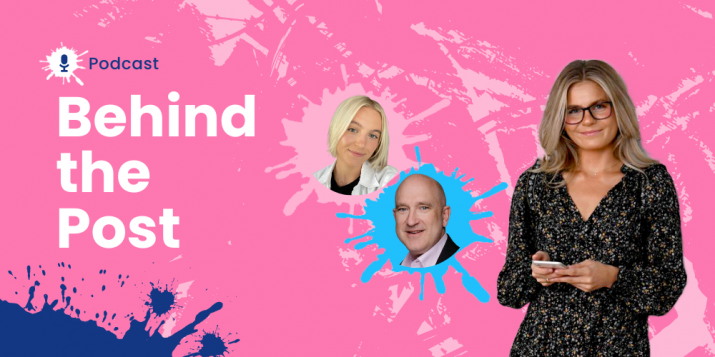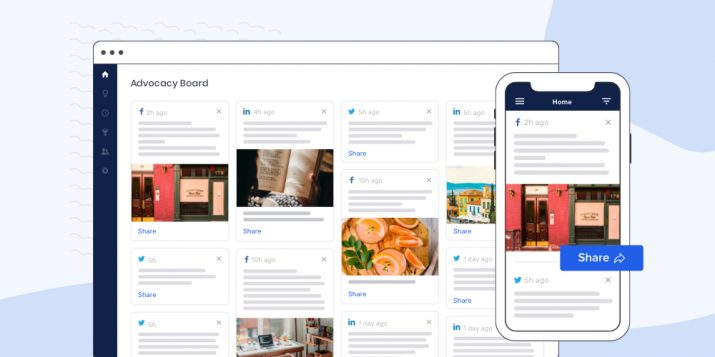
How CMOs can measure and attribute leads to podcasting
Podcasting has become a powerful tool for B2B marketers to engage their audience, build thought leadership, and showcase their expertise. Unlike traditional content formats like blogs and whitepapers, podcasts provide a conversational and engaging way to connect with listeners on a deeper level.
In B2B, podcasts allow CMOs to target niche audiences with relevant, valuable content while positioning their brand as an industry leader. But while the benefits of podcasting are clear, one question remains: How can you measure its impact?
1. The podcast attribution challenge: Why measuring ROI is tough
One of the most significant challenges CMOs face is proving the ROI of their podcasting efforts. Unlike other marketing channels, podcasts don’t offer direct conversion metrics, and tracking their role in the buyer journey can be tricky.
Podcasts often support, spark interest, or nurture relationships early in the funnel. This indirect influence makes it challenging to tie specific leads or opportunities to your podcast. However, podcast attribution can become more measurable and actionable with the right approach to promotion and tracking.
2. The power of incorporating your podcast into an integrated campaign
You can measure and attribute better when you set up your podcast as part of an integrated campaign.
Plan an integrated campaign approach:
Cross-channel reach: Repurpose your content and promote it through multiple platforms, including social media, emails, blogs, newsletters, and even paid advertising; it will maximize audience reach and engagement.
Consistent messaging and branding: By aligning podcast content with broader marketing efforts, you maintain a unified message and aligned topics that reinforce your brand identity and resonate with your target audience across all touchpoints.
Improve campaign effectiveness: Integrating podcasts into a more extensive marketing campaign leverages all marketing channels, driving traffic, generating leads, and creating a measurable impact, ensuring your podcast contributes directly to your overall business goals. Podcasting can become part of your engagement strategy with target accounts, part of your marketing strategy, and part of your sales strategy.
Recommended for further reading
3. Leveraging organic social media to promote and track podcasts
To make podcasting measurable, CMOs need to focus on promotion and engagement. Organic social media, especially LinkedIn, is a critical channel for amplifying your podcast’s reach. Why LinkedIn? It’s where B2B professionals are actively networking, learning, and engaging with industry-relevant content.
Here’s how to maximize LinkedIn for podcast attribution:
- Create campaign-based posts: Build posts highlighting key takeaways, quotes, or guest insights from your podcast episodes.(Don’t forget to tag your guests to tap into their networks!)
- Tag target accounts and influencers: Engage with key stakeholders and encourage them to interact with your content.
- Analyze engagement metrics: Measure likes, comments, shares, and clicks to see how your target audience responds.
These metrics provide valuable insight into which topics resonate most with your audience and can help you refine future content and podcasts.
4. How podcast promotion influences the buyer journey and lead generation
Podcasts are a gateway to your broader marketing funnel when promoted effectively on LinkedIn and other social platforms. Listeners who engage with your podcast posts may visit your website to explore your offerings, download resources, or sign up for a demo.
For example, after seeing a podcast post on LinkedIn, a prospect may click through to learn more about your platform. This exposure builds familiarity and trust, priming them for future conversations with your sales team.
Podcasts also excel as a tool for educating potential buyers. By presenting complex topics in an accessible format, they can nurture leads and influence opportunities over time.
The critical point is that you promote the podcast’s content, but it is not just about listening to it.
5. Podcasts as a strategic component of your content marketing plan
A successful B2B content marketing strategy is diverse and multifaceted. While blogs, guides, and videos remain essential, podcasts bring something unique: authenticity and connection.
Podcasts allow you to address content topics in greater depth and showcase the personality and expertise of your brand’s leaders. They’re not a replacement for other formats but a complement that strengthens your content strategy.
Integrating podcasts into campaign-based content strategies ensures consistency and alignment across channels. When combined with blog posts, social media updates, and videos, podcasts can amplify your message and keep your audience engaged.
6. Using data to track and influence podcast-driven opportunities
Tracking podcast performance starts with the right tools and metrics. Use LinkedIn analytics, or Oktopost, to identify which posts drive the most engagement and clicks. From there, integrate these insights with your CRM or marketing automation platform to see how these engagements influence your pipeline.
Pay close attention to engagement from target accounts. Are key decision-makers commenting, liking, or sharing your podcast posts? If so, it indicates your content is resonating and building momentum with the right audience.
Beyond tracking, use this data to refine your content strategy. For example, if a podcast episode drives significant engagement, consider creating a follow-up episode, blog post, or webinar on the same topic.
7 examples of impactful B2B marketing podcasts
B2B Growth by Sweet Fish Media
- This podcast shares actionable insights on content marketing, account-based marketing (ABM), and more. Sweet Fish Media uses the podcast as a brand leadership tool while nurturing leads through its highly relevant content.
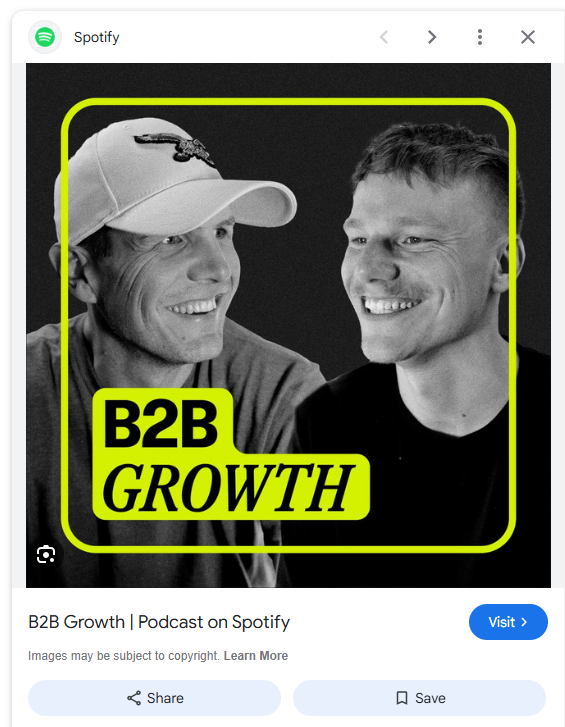
Marketing against the grain by HubSpot
- HubSpot leverages this podcast to discuss inbound marketing strategies and trends. The podcast drives website visits and interest in HubSpot’s marketing tools by sharing practical advice.
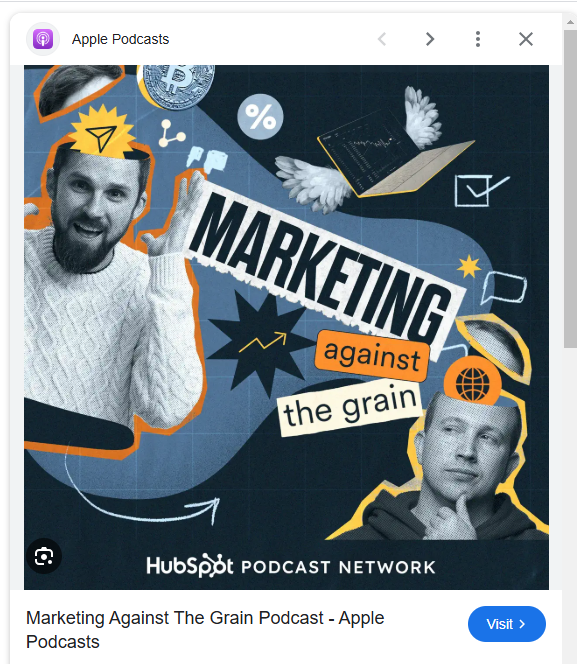
The Marketing Cloudcast by Salesforce
Salesforce focuses on marketing innovation and leadership; this podcast showcases Salesforce’s thought leadership in the marketing technology space. It’s a cornerstone of their content strategy, helping to build trust with prospects.
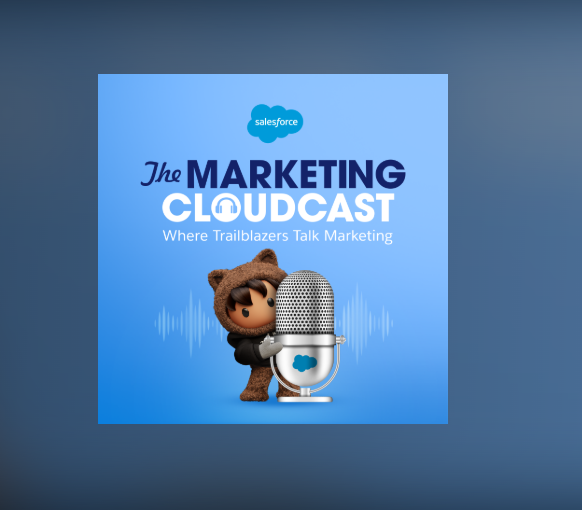
Radically Transparent by Oktopost
Radically Transparent, presented by Oktopost, is a podcast geared towards the modern-day B2B marketer. Each episode shines a light on the inner workings of B2B leadership, including what keeps successful CEOs, CMOs, and VPs up professionally at night. This podcast is a lead-generation marketing tool for Oktopost
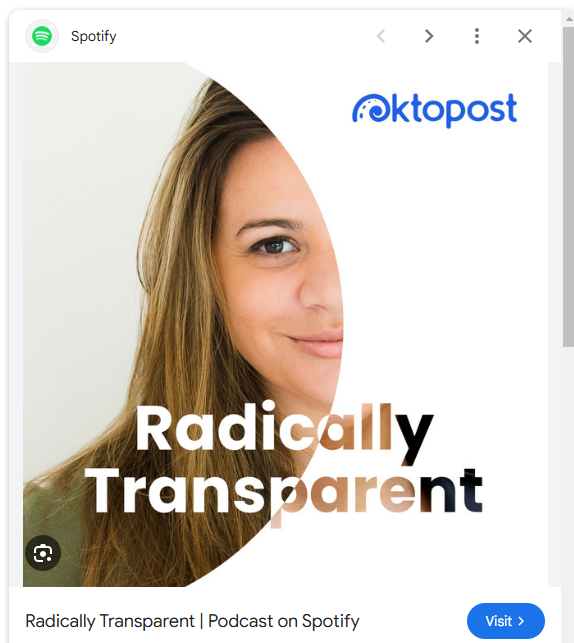
Behind the Post by Oktopost
Behind the Post is a podcast by Social Media Managers for Social Media Managers, from cracking the code of algorithms to crafting thumb-stopping content. His podcast connects the Oktopost user community of social media managers and their peers.
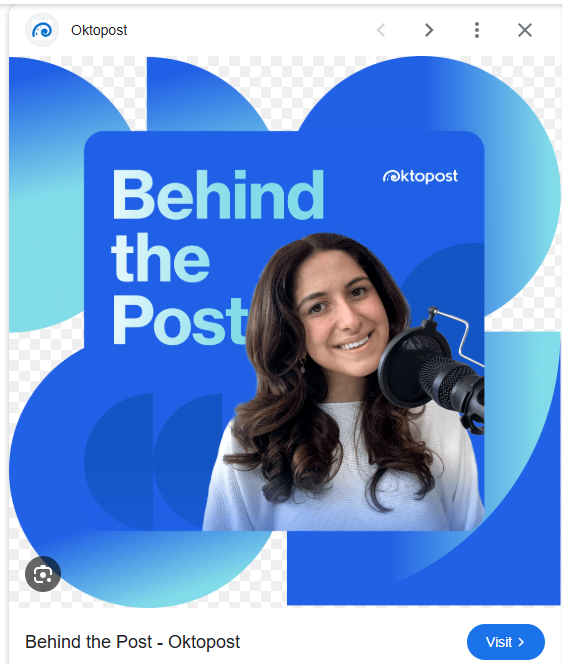
8. Driving growth with podcasts and LinkedIn
Case study: Gong’s Reveal: The Revenue AI podcast by Gong podcast
Gong, a leading revenue intelligence platform, uses its podcast, “Reveal: The Revenue AI Podcast,” to drive brand awareness, engage target accounts, and generate leads.
Strategy:
- Promotion on LinkedIn:
Gong promotes each podcast episode on LinkedIn with targeted campaigns, leveraging highly engaging content such as key takeaways, expert quotes, and actionable insights. Posts often tag guests, who are typically industry thought leaders, increasing the visibility of each episode. - Integrating UTM tracking:
Links to the podcast episodes shared on LinkedIn and other social platforms include UTM parameters. This allows Gong to track traffic to its website directly from podcast promotion efforts. - Cross-Channel strategy:
Gong complements its podcast efforts with blog posts, guides, and videos centered around similar topics, creating a unified and robust content ecosystem.
Results:
- Gong’s podcast episodes regularly attract thousands of listeners, driving website traffic and increasing exposure to its revenue intelligence platform.
- LinkedIn engagement metrics like likes, shares, and comments are key indicators of podcast success and influence over target accounts.
Combining podcasting with strategic LinkedIn promotion and UTM tracking, Gong aligns its podcast content with its lead generation and brand leadership goals. This integration demonstrates how B2B podcasts can influence opportunities when supported by strong attribution strategies.
Reveal, the revenue AI podcast by Gong
Reveal: Gong’s revenue AI podcast features interviews with sales and revenue operations leaders, offering actionable advice and insights for sales professionals. This aligns with Gong’s positioning as a thought leader in revenue intelligence while indirectly promoting its platform.
Lead generation insights
-
-
LinkedIn engagement is a funnel entry point:
- Gong heavily promotes podcast episodes on LinkedIn, using a mix of:
- Short video clips with guest highlights.
- Key insights and actionable takeaways from episodes.
- Posts tagging featured guests and thought leaders to amplify reach.
- LinkedIn is one of Gong’s most effective B2B lead-generation channels. Their posts often receive hundreds of likes, comments, and shares, particularly from target accounts such as sales leaders, CROs, and RevOps professionals.
- While specific metrics from the podcast alone aren’t published, LinkedIn engagement metrics (e.g., post views, clicks, and shares) are a significant indicator of how Gong uses podcasting to attract and nurture leads.
- Gong heavily promotes podcast episodes on LinkedIn, using a mix of:
-
Traffic to Gong’s website from podcast promotions:
- Gong tracks website visits from podcast-related LinkedIn posts and uses UTM tags to assess how these efforts convert visitors into free trial sign-ups or demo requests.
- In a LinkedIn post, Devin Reed, Gong’s revenue leader, shared that content from Gong’s blog, webinars, and podcasts often contributes to a significant portion of inbound inquiries and leads.
-
Pipeline contribution from content-led strategies (Including podcasts):
- In a webinar and various public interviews, Gong shared that its content marketing efforts drive around 80% of its inbound pipeline.
- The podcast is part of a multi-channel strategy integrating blogs, webinars, reports, and social media to funnel interested prospects into their platform.
-
Impact on brand awareness and long-term relationships:
- Gong uses the podcast to engage with industry leaders (e.g., featured guests), who often become customers or advocates.
- By offering value-first content (like the podcast), Gong attracts high-quality leads who are already familiar with their insights and expertise
before engaging with the sales team.
-
More about Gong’s LinkedIn strategy here
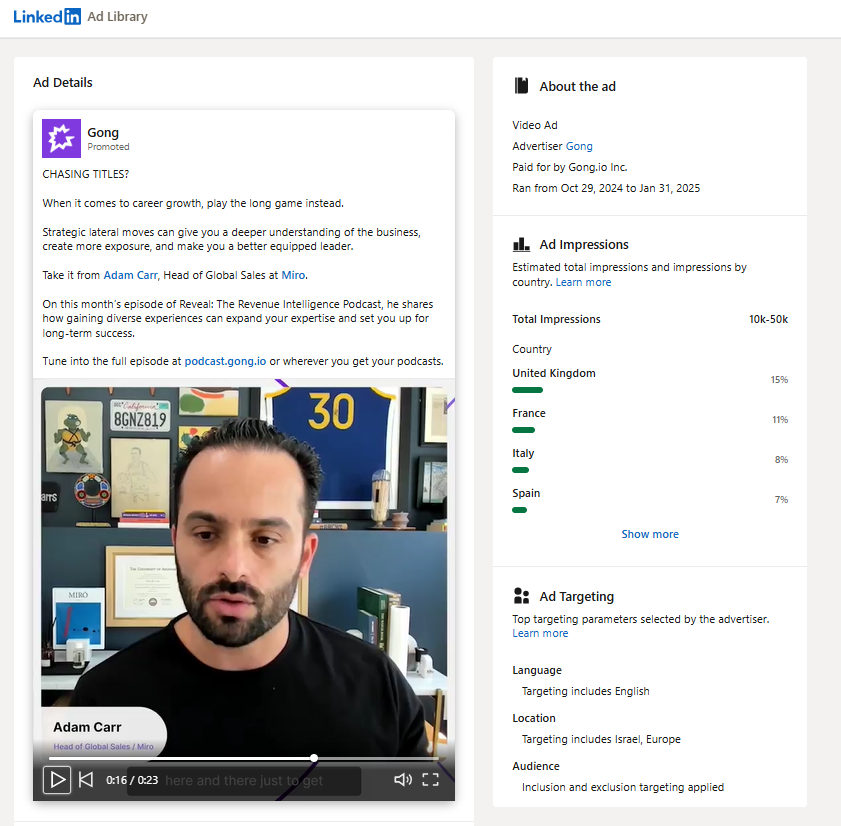
Key metrics
-
Podcast-driven LinkedIn engagement:
- Post impressions, likes, and comments from target accounts.
- Clicks from LinkedIn posts to UTM-tagged podcast links.
-
Traffic to the website:
- UTM-tagged URLs from podcast promotional content.
-
Lead conversion metrics:
- % of podcast-driven visitors who request a demo or sign up for a trial.
-
Podcast listener analytics:
- Analytics of downloads and streams of episodes by topic (via platforms like Spotify, Apple Podcasts, etc.).
Gong demonstrates how podcasts can be a lead-generation engine when integrated with social media promotion, strategic guest selection, and a strong focus on providing value-driven content.
Attribution can be challenging, but Gong’s approach ensures that its podcast serves as both a brand awareness tool and a contributor to inbound leads.
Summary table: Podcast attribution and lead generation
| Attribution Area | Approach | Metrics/Insights |
| LinkedIn Engagement | Promoting podcast episodes on LinkedIn using video clips, guest highlights, and key takeaways. | High engagement from target accounts (e.g., sales leaders, RevOps professionals).
Hundreds of likes, comments, and shares on LinkedIn posts. |
| Website traffic from podcast posts | Uses UTM-tagged links in social media posts to track traffic from podcast promotions. | Tracks visitors to Gong’s website through LinkedIn posts that promote podcast episodes.
Links tied to demo requests or free trial sign-ups. |
| Lead pipeline contribution | Combine podcasts with blogs, webinars, and reports as part of a multi-channel content strategy. | Content marketing (including podcasts) drives ~80% of Gong’s inbound pipeline. |
| Podcast listener analytics | Measures episode downloads and streams on platforms like Spotify and Apple Podcasts. | Listener data helps identify popular topics and refine future episodes. |
| Guest engagement and advocacy | Features industry leaders as podcast guests, fostering relationships with high-value prospects. | Guests often amplify Gong’s reach by sharing episodes and sometimes convert into customers/advocates. |
9. Podcast attribution measurement recommendations
| Attribution method | How It works | Tools to use |
| LinkedIn post engagement | Measure likes, comments, shares, and clicks on podcast promotion posts. | Social media analytics |
| Target account interactions | Track engagement from key decision-makers and target accounts. | CRM and Social data integrations |
| Website traffic from podcast links | Use UTM parameters to track clicks from social media to your website. | Google Analytics, URL builders |
| Podcast downloads and streams | Measure the number of episode downloads and listens on platforms like Spotify. | Podcast hosting platforms |
| Lead generation metrics | Analyze CRM data to connect podcast engagement to opportunities or deals. | HubSpot, Salesforce, Marketo, and other CRMs |
10. Make podcast attribution part of your strategy
While podcast attribution may seem challenging, it’s far from impossible! By leveraging organic social media, particularly LinkedIn, CMOs can track podcast engagement, gain insights into their audience, and refine their content strategies.
When done strategically, podcasting becomes both a brand-leadership tool and a measurable lead-generation tactic. Embrace it as part of your broader B2B marketing plan, and you’ll see its impact on your pipeline and brand reputation grow.
